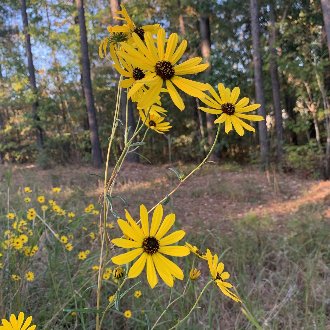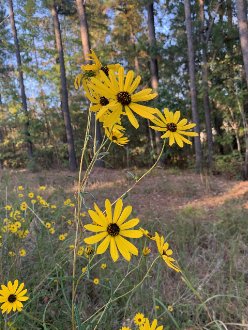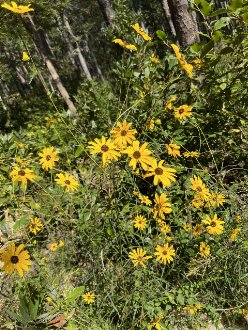Narrowleaf Sunflower (Helianthus angustifolius L.)
Also known as swamp sunflower; also classified as Coreopsis angustifolia L.
We found numerous sources that list Coreopsis angustifolia L. as a synonym of coastal plain tickseed (Coreopsis gladiata), a superficially-similar plant that can also occur in the same habitats where their ranges overlap. This is likely an error caused by misidentification, but it is worth mentioning that that name may also be used in some literature to refer to that other species.
↑Summary
A tall, clumping, late-blooming perennial native to the southeastern to south-central US.
↑Range - Expand
| Legend | Color |
| Native or Not Present | |
| Native | |
| Native or Expanded or Not Present | |
| Native or Expanded |
This map is based on our research. We have checked its accuracy to Level 3 ecoregions. Although this plant occurs somewhere in each of these regions, it may only occur in a small part of some or all of them.
↑Habitat
Found in a variety of sunny to partly sunny habitats along both the Atlantic and Gulf coastal plains, and extending somewhat inland in the south-central US; usually but not always found in wetlands. Its habitat preferences become more generalized in the heart of its range. Natural habitats include open pine flatwoods, savannas, and woodland edges, banks of small streams and ponds, bogs, swamps, marshes, and swales, and occasionally, dry ridges. Also found in anthropogenic habitats including forest plantations, recently clearcut areas, old fields, and occasionally-mowed right-of-ways along forest edges such as under power lines and along roadsides.
Most often found on sandy loam to clay loams, but can be found on a range of soil textures including sand, loam, clay, sandy muck, and sandy peat. It is most common on sites where the soil texture is well-drained but the site itself is poorly-drained. It tolerates a range of soil pH from slightly alkaline to strongly acidic (ranging even into bogs and peatlands), but is less competitive on neutral soils.
Although this species prefers moist to wet conditions and is more likely to occur in wetlands, it can also occur on dry ground, ranging into mesic conditions and even onto dry ridges.
We found conflicting reports of this species' light preferences, with some sources saying it prefers some shade and others it prefers full sun. Its light preferences likely vary in different habitats or parts of its range, with it probably preferring greater shade farther south and in drier habitats. It likely needs a minimum of 2 hours of direct sun and prefers significantly more.
Requires some type of disturbance to maintain the open lighting conditions it prefers; it responds well to both natural disturbances such as fire or flooding, and anthropogenic ones such as logging or sporadic mowing (once a year or less). It cannot survive in regularly mowed areas. Although it can occur in habitats that do not burn, it is most abundant in habitats that burn frequently. It can tolerate fire at any time of year.
Overall, this species has adapted well to humans. It likely benefitted from Native American burning practices, and has readily adapted to more recent changes; although fire suppression has reduced its prevalence where savannas have converted to closed-canopy forests, it adapts readily to other disturbances and human alterations to the environment including logging, plantation forestry, and road building and maintenance.
↑Life Cycle
Swamp sunflower is a tall, clumping, warm-season perennial that blooms later than most sunflowers (Helianthus sp.) and is usually the latest-blooming sunflower in the habitats where it occurs. It can be long-lived when not shaded by taller vegetation.
This plant is a bit unusual in its combination of its tall height, potentially 6-8 feet tall, with its very narrow leaves. This combination of traits allows it to combine significant drought tolerance with good competitive ability against other herbaceous plants. The stem is rather flimsy and relies on such vegetation for physical support. In the absence of supporting vegetation, it often grows shorter, and stems typically sprawl or flop over.
Clumps grow larger over time, with more stems, but do not spread large distances vegetatively; spread farther than a few inches usually happens only by seed.
Foliage usually emerges in April, earlier in the southernmost reaches of its range. Plants grow taller gradually throughout the growing season. Blooms are late, typically peaking in October in most of the range, and extending as late as Decemmber in the south of the range; rarely plants may bloom as early as July. The bloom time is limited by frost, leading this species to have a more restricted bloom period in the north of its range. Because it blooms so late, in some years its seed crop fails due to an early cold spell, which can not only kill the flowers if it is sufficiently cold, but also reduce the availability and activity of pollinators.
Seeds are wind-dispersed, usually only over small distances, and persist in the seed bank in low numbers. We could not find evidence of animals distributing or caching the seed of this species in particular, but mice and small birds aid the distribution of some related species with seeds of similar size, including caching such seed.
Plants can survive repeated top-kill by fire, mowing or cutting, or herbivory. However plants will eventually die if shaded by a closed-canopy forest.
↑Faunal Associations
The stems and leaves are high in protein and are an important browse for deer. The seeds are eaten by the northern bobwhite and various doves.
The flowers are an important nectar source to late pollinators, including migrating monarch butterflies (Danaus plexippus), as they are one of the last flowers blooming before a frost. It also attracts the common long-horned bee (Melissodes communis) and another long-horned bee, brown-winged striped-sweat bee (Agapostemon splendens), Halictus ligatus, Poey's furrow bee (Halictus poeyi), and Augochloropsis metallica, and also leafcutter bees, including Megachile albitarsis, Megachile mendica, Megachile parallela, Megachile petulans, and Coelioxys sayi.
Numerous lepidoptera eat this plant in their larval form, including the silvery checkerspot (Chlosyne nycteis) and painted lady (Vanessa cardui), which eat various plants in the aster family, and in the central US, the gorgone checkerspot (Chlosyne gorgone). The larvae of the black-blotched prominent moth (Oedemasia leptinoides) also eats this species.
↑Uses
This species is occasionally used in landscaping. It is relatively easy to grow within its range, and tolerates a wide range of conditions, especially in a garden environment where competing vegetation is kept away from it. It is valued for its showy flowers that persist much later than other visually-similar flowers, and it also valued for its support of pollinators. Its use in gardens is limited by its tall growth and tendency to flop over.
There are several cultivars available, many of which have significantly altered flower structure including larger and more numerous rays, and a shorter maximum height.
This species has also been planted in rain gardens and stormwater filtration basins, where it can thrive due to its tolerance of both wet and dry conditions. Again, its use in these gardens can be limited by its tendency to flop into nearby paths or roads, but it is often a good choice where space allows.
↑Related Plants
Numerous other Helianthus species overlap with this one in range.
This species is belongs to what is described as the "Southeastern Perennial Clade" of Helianthus. Within this clade, it is closest-related to Florida sunflower (Helianthus floridanus), with which it readily forms hybrids and intergrades. The other species in this clade are longleaf sunflower (Helianthus longifolius), lakeside sunflower (Helianthus carnosus), rayless sunflower (Helianthus radula), purpledisk sunflower (Helianthus atrorubens), rosinweed sunflower (Helianthus silphioides), and variableleaf sunflower (Helianthus heterophyllus).
All of these species are native to the southeastern US.
↑Notes
We prefer the common name "narrowleaf sunflower" to "swamp sunflower" because although this species is often found in wetlands and moist habitats, it is not restricted to these habitats, whereas it always has narrow leaves. Furthermore, numerous Helianthus species can occur in wetlands and/or moist habitats, whereas this species stands out from others of its genus in having unusually narrow leaves.
We also found some sources that refer to "narrow-leaved coreopsis" as a common name for this species; we recommend against using this name as it is highly misleading and inaccurate as this species is not in the Coreopsis genus and can be easily distinguished from plants of that genus by the shape of its rays. Furthermore that common name could be easily confused with lanceleaf tickseed (Coreopsis lanceolata) in particular.
↑Links & External Resources
• Helianthus angustifolius (swamp sunflower) | USDA PLANTS Database (About This Site)
• Narrowleaf Sunflower | iNaturalist (About This Site)
• Helianthus angustifolius | Biota of North America Project (BONAP) (About This Site)
• Helianthus angustifolius | NatureServe Explorer (About This Site)
• Helianthus angustifolius | Flora of North America (About This Site)
• Helianthus angustifolius | Missouri Plants (About This Site)
• Swamp Sunflower | Maryland Biodiversity Project (About This Site)
• Helianthus angustifolius L. | Plants of the World Online (POWO) (About This Site)
• Helianthus angustifolius L. (Narrow-leaved Sunflower) | Digital Atlas of the Virginia Flora (About This Site)





